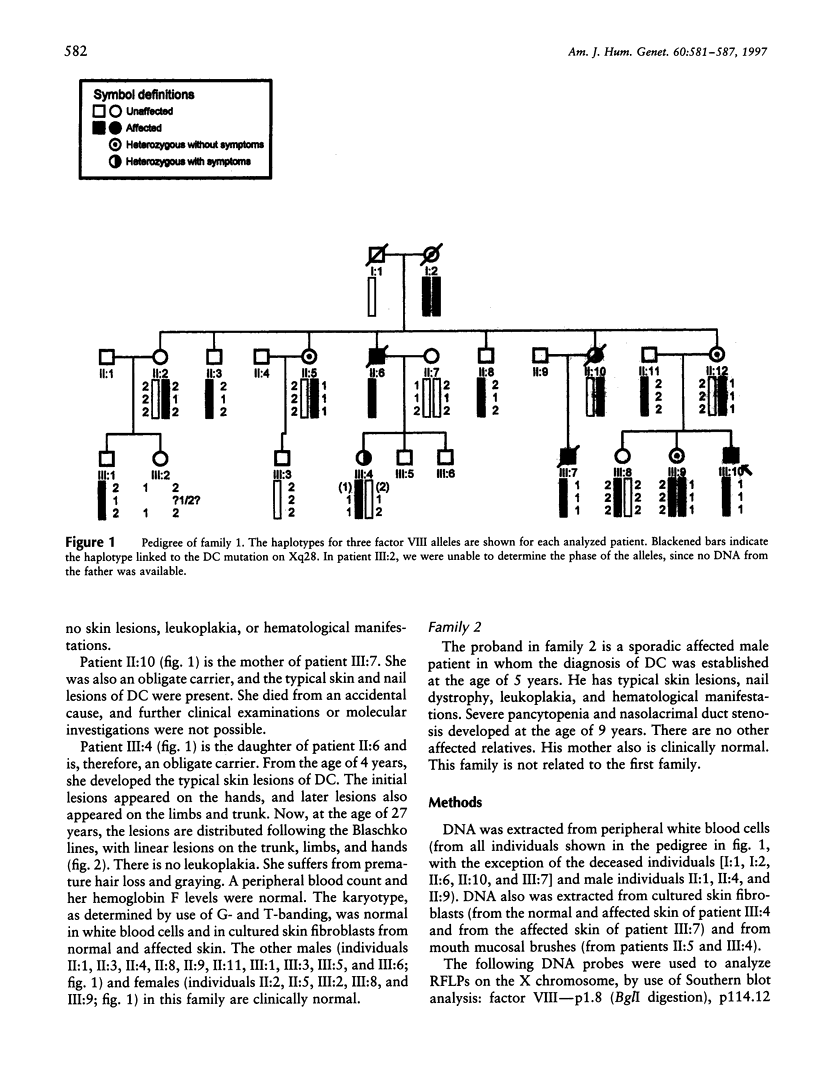Abstract
In this study, we report on a family with X-linked dyskeratosis congenita (DC). Linkage analysis with markers in the factor VIII gene at Xq28 yielded a LOD score of 2 at a recombination of 0. Clinical manifestations of DC, such as skin lesions following the Blaschko lines, were present in two obligate carrier females. Highly skewed X inactivation was observed in white blood cells, cultured skin fibroblasts, and buccal mucosa from female carriers of DC in this family. This suggests a critical role for the DC gene in bone marrow-cell and fibroblast-cell proliferation.
Full text
PDF






Images in this article
Selected References
These references are in PubMed. This may not be the complete list of references from this article.
- Allen R. C., Zoghbi H. Y., Moseley A. B., Rosenblatt H. M., Belmont J. W. Methylation of HpaII and HhaI sites near the polymorphic CAG repeat in the human androgen-receptor gene correlates with X chromosome inactivation. Am J Hum Genet. 1992 Dec;51(6):1229–1239. [PMC free article] [PubMed] [Google Scholar]
- Arngrimsson R., Dokal I., Luzzatto L., Connor J. M. Dyskeratosis congenita: three additional families show linkage to a locus in Xq28. J Med Genet. 1993 Jul;30(7):618–619. doi: 10.1136/jmg.30.7.618. [DOI] [PMC free article] [PubMed] [Google Scholar]
- Belmont J. W. Genetic control of X inactivation and processes leading to X-inactivation skewing. Am J Hum Genet. 1996 Jun;58(6):1101–1108. [PMC free article] [PubMed] [Google Scholar]
- Connor J. M., Gatherer D., Gray F. C., Pirrit L. A., Affara N. A. Assignment of the gene for dyskeratosis congenita to Xq28. Hum Genet. 1986 Apr;72(4):348–351. doi: 10.1007/BF00290963. [DOI] [PubMed] [Google Scholar]
- Davidson H. R., Connor J. M. Dyskeratosis congenita. J Med Genet. 1988 Dec;25(12):843–846. doi: 10.1136/jmg.25.12.843. [DOI] [PMC free article] [PubMed] [Google Scholar]
- De Boeck K., Degreef H., Verwilghen R., Corbeel L., Casteels-Van Daele M. Thrombocytopenia: first symptom in a patient with dyskeratosis congenita. Pediatrics. 1981 Jun;67(6):898–903. [PubMed] [Google Scholar]
- Dokal I., Bungey J., Williamson P., Oscier D., Hows J., Luzzatto L. Dyskeratosis congenita fibroblasts are abnormal and have unbalanced chromosomal rearrangements. Blood. 1992 Dec 15;80(12):3090–3096. [PubMed] [Google Scholar]
- Drachtman R. A., Alter B. P. Dyskeratosis congenita: clinical and genetic heterogeneity. Report of a new case and review of the literature. Am J Pediatr Hematol Oncol. 1992 Nov;14(4):297–304. [PubMed] [Google Scholar]
- Happle R. Lyonization and the lines of Blaschko. Hum Genet. 1985;70(3):200–206. doi: 10.1007/BF00273442. [DOI] [PubMed] [Google Scholar]
- Lathrop G. M., Lalouel J. M. Easy calculations of lod scores and genetic risks on small computers. Am J Hum Genet. 1984 Mar;36(2):460–465. [PMC free article] [PubMed] [Google Scholar]
- Maleville J., Le Roy J. M., Diard F., Boiron G., Mollard S., Massicot P., Guillet G. Une association inédite: "dyskératose de Zinsser-Cole-Engmann", "syndrome de Klippel-Feil" et "malformation de Sprengel". Ann Dermatol Venereol. 1980;107(12):1207–1211. [PubMed] [Google Scholar]
- Marsh J. C., Will A. J., Hows J. M., Sartori P., Darbyshire P. J., Williamson P. J., Oscier D. G., Dexter T. M., Testa N. G. "Stem cell" origin of the hematopoietic defect in dyskeratosis congenita. Blood. 1992 Jun 15;79(12):3138–3144. [PubMed] [Google Scholar]
- Moss C., Larkins S., Stacey M., Blight A., Farndon P. A., Davison E. V. Epidermal mosaicism and Blaschko's lines. J Med Genet. 1993 Sep;30(9):752–755. doi: 10.1136/jmg.30.9.752. [DOI] [PMC free article] [PubMed] [Google Scholar]
- Naumova A. K., Plenge R. M., Bird L. M., Leppert M., Morgan K., Willard H. F., Sapienza C. Heritability of X chromosome--inactivation phenotype in a large family. Am J Hum Genet. 1996 Jun;58(6):1111–1119. [PMC free article] [PubMed] [Google Scholar]
- Pai G. S., Morgan S., Whetsell C. Etiologic heterogeneity in dyskeratosis congenita. Am J Med Genet. 1989 Jan;32(1):63–66. doi: 10.1002/ajmg.1320320114. [DOI] [PubMed] [Google Scholar]
- Sirinavin C., Trowbridge A. A. Dyskeratosis congenita: clinical features and genetic aspects. Report of a family and review of the literature. J Med Genet. 1975 Dec;12(4):339–354. doi: 10.1136/jmg.12.4.339. [DOI] [PMC free article] [PubMed] [Google Scholar]
- Thomas I. T., Frias J. L., Cantu E. S., Lafer C. Z., Flannery D. B., Graham J. G., Jr Association of pigmentary anomalies with chromosomal and genetic mosaicism and chimerism. Am J Hum Genet. 1989 Aug;45(2):193–205. [PMC free article] [PubMed] [Google Scholar]
- Verra F., Kouzan S., Saiag P., Bignon J., de Cremoux H. Bronchoalveolar disease in dyskeratosis congenita. Eur Respir J. 1992 Apr;5(4):497–499. [PubMed] [Google Scholar]
- Vogelstein B., Fearon E. R., Hamilton S. R., Preisinger A. C., Willard H. F., Michelson A. M., Riggs A. D., Orkin S. H. Clonal analysis using recombinant DNA probes from the X-chromosome. Cancer Res. 1987 Sep 15;47(18):4806–4813. [PubMed] [Google Scholar]
- Womer R., Clark J. E., Wood P., Sabio H., Kelly T. E. Dyskeratosis congenita: two examples of this multisystem disorder. Pediatrics. 1983 Apr;71(4):603–609. [PubMed] [Google Scholar]




